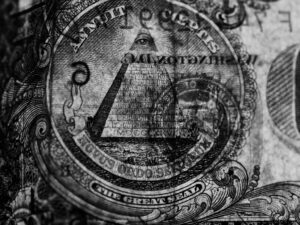France’s modern colonies: the CFA Franc System
By Luke Belnap
By Luke Belnap
When France began colonizing large portions of Africa in the 19th century, it justified its conquest under the guise of the so called “mission civilisatrice”, the idea that France was bringing civilization, progress, and economic development to the continent. In reality, this was an idea manufactured to justify France’s exploitation, forced labor, and economic extraction of their colonies. The French colonialism of Africa was designed to serve the interests of Paris, not the people of Africa.
For nearly a century, France ruled over vast territories in West and Central Africa, plundering resources while forcing African subjects to fight in French wars.
But as the winds of decolonization swept through Africa in the mid-20th century, these nations demanded independence. One by one, they gained their political freedom in the 1950s and 60s, ending direct colonial rule—or so it seemed.
While the French flag may have disappeared from African capitals, France never actually left. Instead, France just rebranded its oppressive control, swapping a military occupation for an economic one.
At the heart of this economic hegemony was the CFA franc, a currency designed to keep African economies forever tied to France, even after independence. Today, 14 supposedly sovereign African nations still use this colonial-era currency, limiting their economic freedom and reinforcing their dependence on Paris.
The CFA franc (Franc des Colonies Francais d’Afrique) was introduced in 1945, well before France’s decolonization in the late 1950s, as a way for France to control the economies of its African colonies.
Even though the participating nations have all now gained independence, the currency remains in place under two regional monetary unions:
The first of these unions is UEMOA (West African Economic and Monetary Union). Using the West African CFA franc, or the XOF, this union includes the countries of Senegal, Burkina Faso, the Ivory Coast, Benin, Guinea-Bissau, Niger, Togo, and Mali.
The second of these unions is CEMAC, the Central African Economic and Monetary Community. This group uses the Central African CFA franc, or the XAF, and includes Cameroon, Gabon, Chad, the Republic of Congo, the Central African Republic, and Equitorial Guinea.
Both these currencies were pegged to the value of the franc (which was later swapped to the euro) and were guaranteed by the French Treasury. In exchange, UEMOA and CEMAC member states had to deposit 50% of their foreign exchange reserves in France’s central bank, a policy that severely limited their financial independence.
Although France finally agreed to reforms in 2019 that would end the 50% reserve deposit requirement and remove French representatives from regional central banks, critics argue that these changes are superficial, and that the heart of the CFA franc system still operates as economic colonialism and French imperialism.
Despite being in use for over 80 years, the CFA franc has largely failed to promote economic development in its member states. Many of the CFA franc member states remain the poorest countries in the world, with high levels of unemployment, weak industrialization, and dependence on raw material exports.
Unlike independent nations that can control their currency to respond to economic crises, CFA franc countries almost completely lack any monetary policy autonomy. Since the CFA franc’s value is tied to the euro, its value is dictated by European Central Bank policies, which do not prioritize African economies. This prevents countries from devaluing their currency to boost exports and from adjusting interest rates to stimulate economic growth.
For example, during the 2008 global financial crisis, many independent nations adjusted their currencies to cushion the economic shock. CFA franc nations, however, were forced to follow European monetary policies that were not tailored to their needs. This lack of autonomy severely impacted member states’ ability to curb the economic impact of the financial crisis.
One of the most controversial aspects of the CFA franc system is the requirement that African countries deposit 50% of their foreign exchange reserves in the French Treasury. This meant African nations had extremely limited control over their own money and often had to request France’s permission to access their own reserves. Although this policy was repealed in 2019, it only showed the persistence of this strict level of colonial-era control through the decades.
Furthermore, the fixed exchange rate with the euro made CFA franc countries attractive mostly to French and European investors while actively discouraging local industrialization. Because the currency remains overvalued, it makes African CFA countries’ exports less competitive on the global market while making it cheaper to import European goods. This destroys local industries and increases unemployment.
The CFA franc system creates long-term economic dependence rather than fostering growth. Many CFA franc countries remain stuck in a cycle where they export raw materials and import finished goods from France and Europe. This only benefits colonial powers while preventing industrialization in Africa.
For instance, the Ivory Coast is one of the world’s largest cocoa producers, but instead of processing and exporting chocolate, it exports raw cocoa beans to Europe, where they are processed and sold back to the Ivory Coast at a much higher value.
This imbalance ensures that African nations remain suppliers of cheap resources rather than becoming industrialized economies.
By controlling the CFA franc, France also exerts considerable political influence over its former African colonies. Leaders who oppose the system or seek greater economic independence often face political and economic pressure from France. In some cases, African leaders who challenge French dominance have even been overthrown and assassinated by forces tied to France.
For example, upon their independence in 1960, the country of Guinea was one of the few former French colonies with a leader who was not trained in France as a loyal French ally. They rejected the CFA franc and drew up their own currency. When Guinea issued this new currency, France responded harshly.
“As a warning to other French-speaking territories, the French pulled out of Guinea over a two-month period, taking everything they could with them. They unscrewed lightbulbs, removed plans for sewage lines in Conakry, the capital, and even burned medicines rather than leave them to the Guineans,” reported The Washington Post.
After their withdrawal, France organized Operation Persil, an operation designed to sabotage Guinea and their new currency. In this operation, France produced large quantities of counterfeit banknotes to flood into Guinea to ramp up inflation and beget economic collapse. This operation was also meant to arm opposition groups in Guinea and organize a civil war. However, after Senegal intercepted a large French-organized shipment of weapons to Guinea, leading both the countries to file official complaints, Operation Persil was scrapped.
Mali initially accepted the CFA franc with their independence in 1960 but decided to leave the system in 1962 under President Modibo Keïta, introducing the Malian franc as its own currency. France reacted with economic sabotage, political isolation, and a forcible regime change. France blocked Malian exports, withdrew financial support, and made it difficult for Mali to trade with CFA franc countries. This created huge barriers for Mali to stabilize its new currency. In 1968, Keïta was overthrown in a French-backed military coup, and the new government immediately returned to the CFA franc system.
On the other hand, African leaders who supported French economic policies often received and still receive financial backing and political protection. This dynamic often keeps corrupt elites in power while preventing real economic and political reform.
In recent years, opposition to the CFA franc has grown across Africa. Many young activists and political leaders see it as a symbol of colonial exploitation and are demanding monetary independence.
In 2019, West African leaders announced to replace the CFA franc with the “Eco”, a new regional currency. However, France intervened in the process to ensure that the new currency remained pegged to the euro. This led critics to argue that the Eco was just a rebranded CFA franc, and that yet another French intervention had rendered the entire reform process redundant. This led to protests erupting in Senegal, Mali, and Chad, with activists calling for a complete break from French control.
Meanwhile, the African nations who were former colonies and who did not participate in the CFA franc system, like Ghana and Nigeria, have experienced greater monetary independence and economic flexibility, which shows us that alternative models are possible.
The CFA franc system is one of the clearest examples of modern colonialism, ensuring that African economies remain tied to French economic interests rather than developing their own paths to growth. While France and its allies argue that the system provides financial stability, in reality, it prevents true economic sovereignty and keeps African nations dependent on external powers. For Africa to achieve real independence, it must break free from the CFA franc system and establish truly independent currencies.
This fight against the CFA franc is a fight against neocolonial economic policies that prioritize European interests over African prosperity. This fight isn’t just about money, it’s about freedom, sovereignty, and self-determination. Until these nations control their own economic policies, true independence will remain a mere illusion to the majority of France’s former African colonies.




